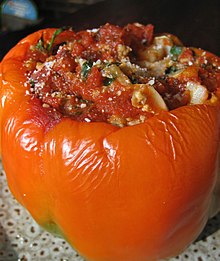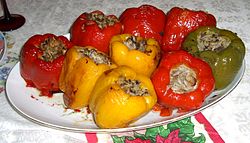Stuffed peppers
This article needs additional citations for verification. (January 2020) |
 | |
| Main ingredients | Peppers |
|---|---|
Stuffed peppers is a dish common in many cuisines. It consists of hollowed or halved bell peppers filled with any of a variety of fillings, often including meat, vegetables, cheese, rice, or sauce. The dish is usually assembled by filling the cavities of the peppers and then cooking.
China

The
Spain
Stuffed peppers or pimientos rellenos are part of traditional Spanish cuisine, especially that of the region of the Basque Country. Usually piquillo peppers are used.[3] The fillings might include Manchego cheese, chicken, or cod in a red sauce, with chicken likely being the most popular recipe.
India
Stuffed peppers (bharvan mirch or bharva hari mirch) is one of several stuffed vegetable (
Mirchi bajji or
Eastern Mediterranean

North America

Stuffed peppers in
Mexican and “Tex-Mex” cuisine has more than one stuffed pepper dish:
- The chile relleno, literally "stuffed pepper", consists of a roasted and peeled/skinned green pasilla or salsaand other toppings. This is also a popular offering at Tex-Mex restaurants in the southwestern U.S., but often cheddar cheese replaces the queso fresco.
- Jalapeño poppers are jalapeño peppers that have been hollowed out, stuffed with a mixture of cheese, spices, and sometimes ground meat, and then deep fried. The dish is common in Tex-Mex cuisine and less so in true Mexican cooking.
Guatemala
In Guatemala, the "pimiento" pepper is stuffed with shredded pork and vegetables. As the Mexican version, it is covered with egg batter and fried. It is served with tomato sauce or inside a bread bun.
Nordic and Baltic countries
- Nordic countries: Fyldte peberfrugter (Danish), Täytetyt paprikat (Finnish), Fylltar paprikur (Icelandic), Fylt paprika (Norwegian), Fyllda paprikor (Swedish).
- Baltic countries (Baltic States): Kimšti pipirai (Lithuanian) usually made with ground beef (or pork), rice, various vegetables and spices; Pildīti pipari (Latvian) and Täidisega paprika (Estonian) is word phrase for "stuffed peppers".
Central and Southeast Europe




There are many names for stuffed peppers in the languages of Central and Southeast Europe:
- biber dolmasi (Turkish)
- Bibər dolması (Azeri)
- Filana paprika or Punjena paprika (Croatian)
- Speca të mbushur (Albanian)
- Γεμιστά (Gemista) (Greek)
- Punjena paprika (Bosnian)
- Пуњена паприка (Serbian)
- Filana paprika or Polnjena paprika (Slovenian)
- Faszerowana papryka (Polish)
- Gefüllte Paprika (German)
- Töltött paprika (Hungarian)[10]
- Полнети пиперки (Polneti piperki) (Macedonian)
- Plněná paprika (Czech)
- Plnená Paprika (Slovak)
- Пълнени чушки (Pulneni chushki) (Bulgarian)
- Фаршированный перец (Russian)
- Фарширований перець (Ukrainian)
- Ardei umpluți (Romanian)
The Hungarian variant, töltött paprika, is always made with Hungarian wax pepper, which has a distinctive taste somewhat similar to lecsó. Punjena paprika (pronounced [pûɲenaː pǎprika]) includes a tomato sauce. In Bulgaria, stuffed peppers are usually eaten with yogurt. Another variety of stuffed peppers in Bulgaria is made with mixed white cheese and eggs instead of meat and rice as stuffing.[citation needed]
In 2017, dolma making in Azerbaijan was included in the UNESCO Intangible Cultural Heritage Lists.[11]

In Romanian cuisine, stuffed peppers are usually prepared with bell peppers stuffed with ground meat (usually pork), rice, onion, and other vegetables and spices and then boiled in a sauce made from cream, tomatoes, and spices.[citation needed]
Traditionally in Bulgaria, the filling is made of rice steamed in advance, onions, minced meat and spices, heat-treated and crammed into pre-cleaned, washed and riddled with needle peppers. After filling of peppers, they are put in a baking dish, water is added and the dish is baked in the oven. If raw egg is added to the cooled stuffing, filled peppers can be cooked in a pan, as the pods are boiled almost steamed.
Besides minced meat and rice, other fillings may be used, such as vegetables (for example leek) and rice, beans, or fresh cheese and eggs. The peppers themselves can be either fresh or dried. Dried red peppers are used especially in southeastern Serbia around Pirot and Dimitrovgrad, often in winter.
Stuffed peppers are often cooked by Romani people and is a popular dish in Romani cuisine.[12]
See also
References
- ^ 韓詠儀 (2017-12-06). "【煎釀三寶食譜】香港特色街頭小食 小點醫肚晚餐佐飯一樣得". 香港01 (in Chinese (Hong Kong)). Retrieved 2022-01-06.
- ^ Food, U. "【簡易食譜】簡單4步就煮到! 街頭滋味小食煎釀三寶 | U Food 香港餐廳及飲食資訊優惠網站". U Food. Retrieved 2022-01-06.
- ISBN 9781627888448. Retrieved 14 January 2020.
- ISBN 9781519729637. Retrieved 14 January 2020.
- ISBN 978-0-19-964024-9. Archivedfrom the original on 2018-06-30. Retrieved 2018-06-29.
- ^ "Dolma". Merriam Webster.
- ISBN 9780684818702. Retrieved 14 January 2020.
- ^ Parloa, Maria (1887). Miss Parloa's Kitchen Companion (19th ed.). New York, New York: The Clover Publishing Co. p. 525. Retrieved 16 January 2012.
- ^ Farmer, Fannie Merritt (1896). The Boston Cooking School Cookbook. Boston, Massachusetts: Little, Brown & Co. pp. 267–268. Retrieved 16 January 2012.
- ^ June Meyers Authentic Hungarian Heirloom Recipes Cookbook
- ^ Dolma making and sharing tradition, a marker of cultural identity Archived 2017-12-07 at the Wayback Machine. UNESCO Intangible Cultural Heritage.
- ^ "Inside the Culinary Traditions of the Roma people". December 7, 2018. Retrieved June 23, 2021.
